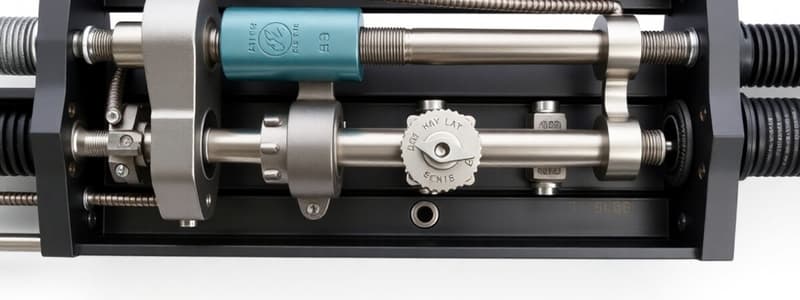Podcast
Questions and Answers
What is the primary focus of kinetics?
What is the primary focus of kinetics?
- The description of the path of a moving object.
- The study of motion without considering the forces involved.
- The measurement of displacement and velocity.
- The analysis of forces that cause motion. (correct)
Which of the following is NOT a component of a lever system?
Which of the following is NOT a component of a lever system?
- Resistance
- Effort
- Pulley (correct)
- Fulcrum
If the axis of a lever is moved closer to the resistance force, what happens to the mechanical advantage?
If the axis of a lever is moved closer to the resistance force, what happens to the mechanical advantage?
- The mechanical advantage decreases.
- The mechanical advantage increases. (correct)
- The mechanical advantage fluctuates depending on the lever class.
- The mechanical advantage remains the same.
What class of lever system is characterized by the resistance force being located between the axis and the effort force?
What class of lever system is characterized by the resistance force being located between the axis and the effort force?
Which of the following statements accurately describes torque?
Which of the following statements accurately describes torque?
Which of Newton's Laws of Motion describes the tendency of an object to resist changes in its state of motion?
Which of Newton's Laws of Motion describes the tendency of an object to resist changes in its state of motion?
Two objects with equal masses are moving at different speeds. Which object possesses greater momentum?
Two objects with equal masses are moving at different speeds. Which object possesses greater momentum?
Which type of friction is typically the lowest in magnitude?
Which type of friction is typically the lowest in magnitude?
Flashcards
Kinematics vs Kinetics
Kinematics vs Kinetics
Kinematics studies motion without forces; Kinetics studies forces that cause motion.
Mechanical Advantage
Mechanical Advantage
Mechanical advantage helps lift heavy objects by providing either force or speed/ROM benefits.
Components of a Lever System
Components of a Lever System
A lever system includes axis, force, and resistance as its main components; an axle is not one of them.
Class of Levers
Class of Levers
Signup and view all the flashcards
Torque
Torque
Signup and view all the flashcards
Newton's First Law
Newton's First Law
Signup and view all the flashcards
Momentum vs Inertia
Momentum vs Inertia
Signup and view all the flashcards
Types of Friction
Types of Friction
Signup and view all the flashcards
Study Notes
Mechanics Study Notes
- Kinetics is the study of forces that cause motion.
- Machines provide a force advantage when lifting heavy objects.
- A lever system's components are force, axis, resistance, and fulcrum.
- Lever classes: Different lever classes (first, second, and third) have varying mechanical advantages based on the relative positions of the axis, force, and resistance. A lever provides a mechanical advantage if the force arm is longer than the resistance arm.
- An example of a lever system can be seen in the second image; a longer force arm produces a greater mechanical advantage. Therefore, moving the axis closer to the resistance will decrease the mechanical advantage.
- Third-class levers are beneficial for speed & range of motion (ROM).
- Torque is force applied at a distance from a rotational axis. Increasing the distance from the axis of rotation increases torque.
- The linear velocity of motion from angular motion is greater with a larger radius. Therefore a larger radius increases velocity.
- Newton's First Law of Motion (Inertia): A body in motion stays in motion or a body at rest stays at rest unless acted upon by an outside force.
- Momentum and inertia are not the same. Momentum considers both mass and velocity.
- Momentum is calculated by multiplying mass times velocity. Greater momentum results in greater resistance to change in motion. Person 3 has the greatest momentum, and therefore is the most resistant to change in motion and is least likely to fall down. Person 3 is the most resistant to change in motion and is least likely to fall.
- Ground Reaction Force is important for jumping and other movements. Without adequate Ground Reaction Force, a jump will be lower.
- Rolling friction provides the lowest resistance to movement.
Studying That Suits You
Use AI to generate personalized quizzes and flashcards to suit your learning preferences.




